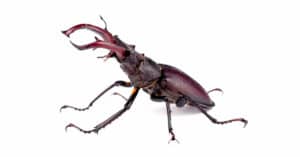Beetles are the most common type of insect. There are many different types of beetles, all the way from the hardy dung beetle to the pesky weevil to the cute ladybug. While the following is not a complete list of beetles, it will tell you the facts about the most common types of beetles, including identification, size in length, diet, and scientific name.
1. Ladybug
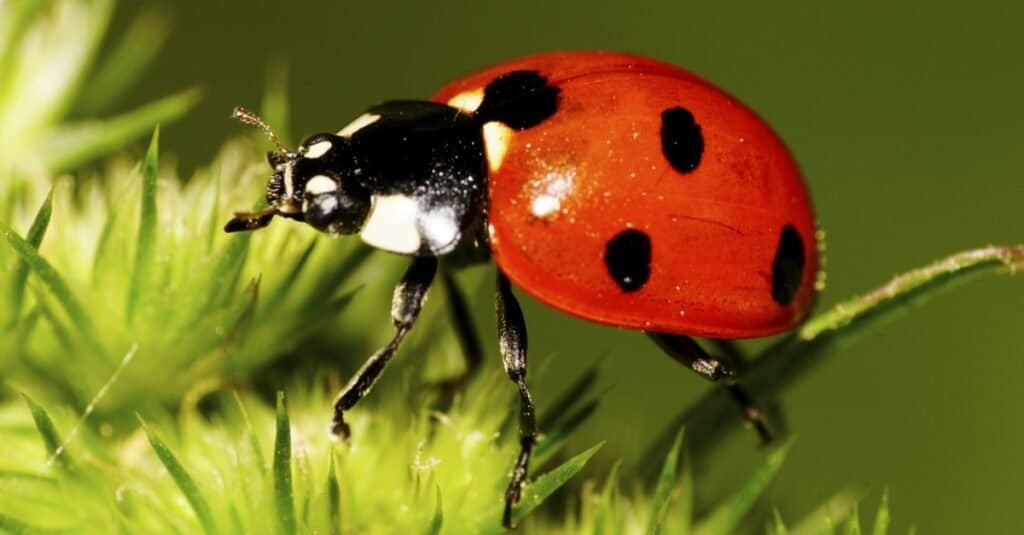
© Sergey/Shutterstock.com
Ladybugs, also called lady beetles and ladybird beetles, have an omnivorous diet of fungus, leaves, beetle larvae, aphids, and other plant-eating pests. They live in Asia, Europe, and North America. Their colors are red, orange, yellow, black, grey, and brown, and their size is 0.8-18mm. Their scientific name is Coccinellidae, which has over 5,000 species.
2. Carrion
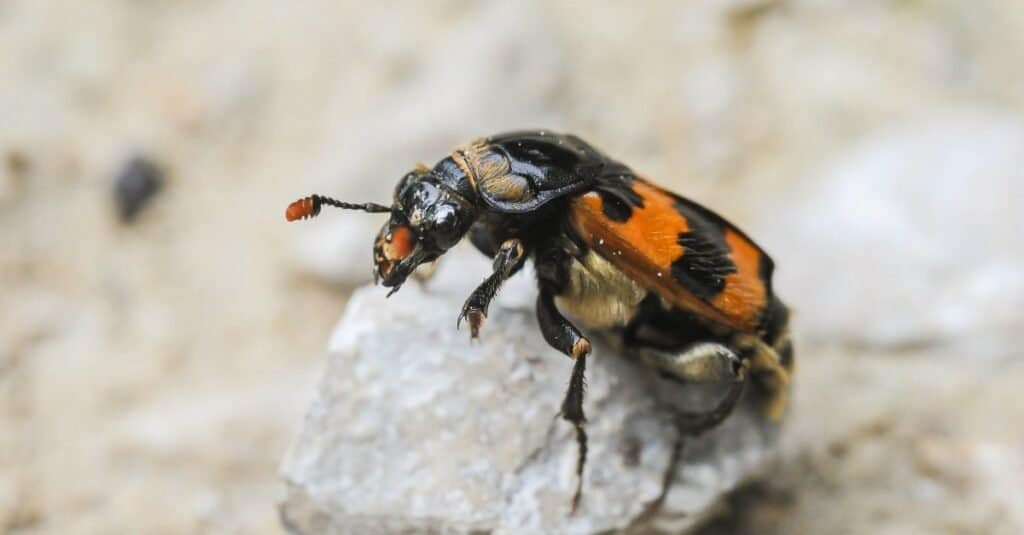
©iStock.com/Stefan Rotter
Also called burying beetles, carrion beetles are found during any stage of decay. They live in North America and are mostly black, with a size of 9-30mm. Their scientific name is Silphidae and there are over 21 species.
3. Flesh-eating

©Tomasz Klejdysz/Shutterstock.com
Flesh-eating beetles have the scientific name of Dermestidae and are also called skin, hide, and taxidermy beetles due to their unique ability to digest keratin. They are found on bodies that have been decomposing for weeks as well as in homes, and they are used to clean bones for identification. Their size is 10-25mm and their colors range from red to brown and black, with long bodies.
4. Rove
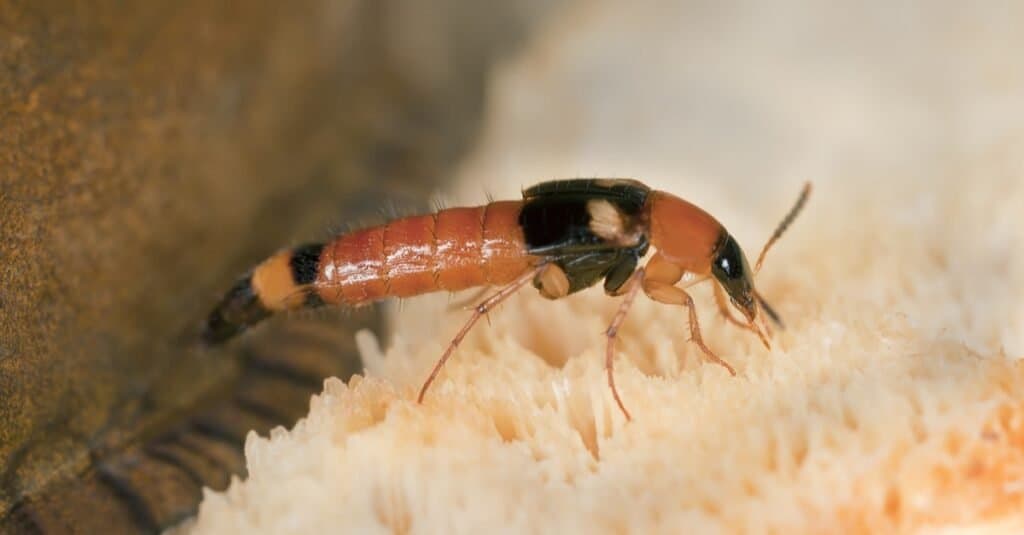
©Henrik Larsson/Shutterstock.com
The scientific name of rove beetles is Staphylinidae, which has 63,000 species and thousands of genera, making them one of the most common types of beetles. The most famous is the Devil’s horse-coach beetle. They can be less than 1 to 35mm long but most have a size of 2-7.6 mm. Their colors range from reddish-brown, brown, red, and yellow to black and iridescent green and blue. Living in moist, humid environments around the world, their diet is plant-eating and scavenging insects.
5. Weevil
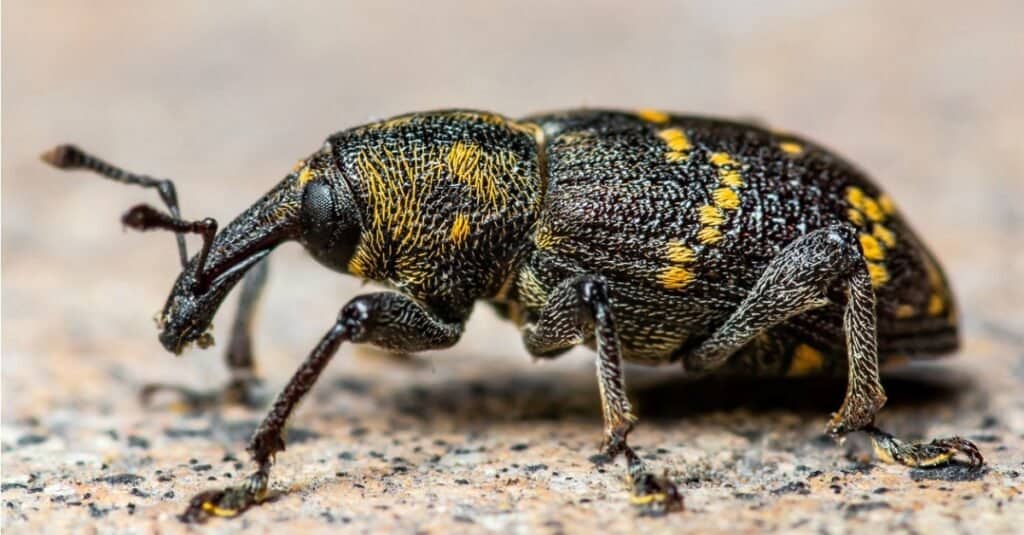
©iStock.com/nechaev-kon
Weevils have the scientific name Curculionoidea. Their long snouts and size of about a quarter-inch or 6mm make identification easy. Their colors range from brown to black and their bodies can be oval or slender in shape. There are 97,000 species, making them one of the most common types of beetles. Their diet is crops, with specific crops depending on species. They live in crops, crop storage facilities, and homes. One common species is the Fuller rose beetle, which is broad-nosed.
6. Ground
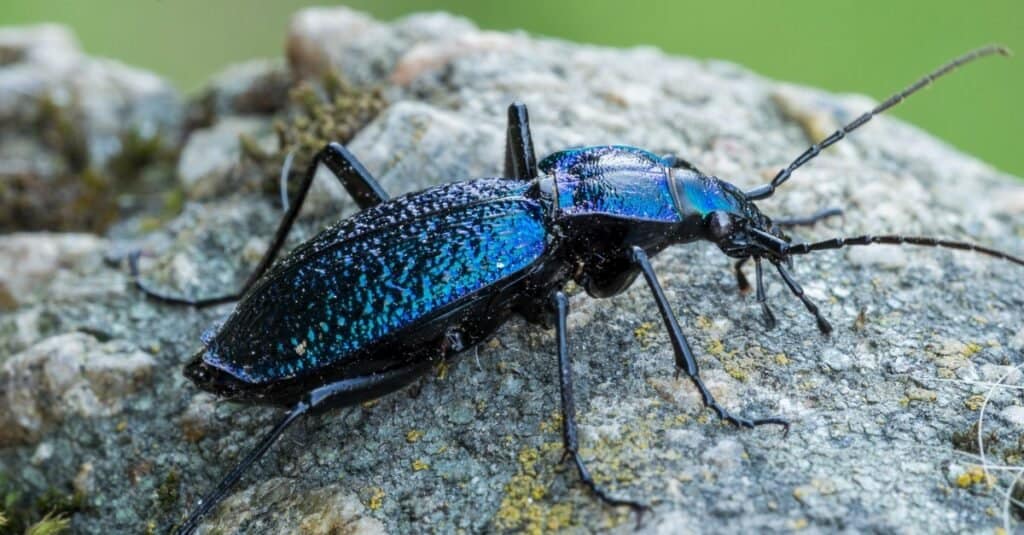
©iStock.com/mirceax
Ground beetles live in many habitats on the ground and have a diet of other insects, larvae, worms, snails, slugs, and seeds of plants including weeds. Their scientific name is Carabidae which has 40,000 species around the world. Most being metallic or shiny black, they come in a range of colors and sizes but all have ridged wing covers. All have volatile defensive secretions and those of bombardier beetles make loud popping sounds. One major genus is Harpalus and one well-known species is the violin beetle.
7. Scarab
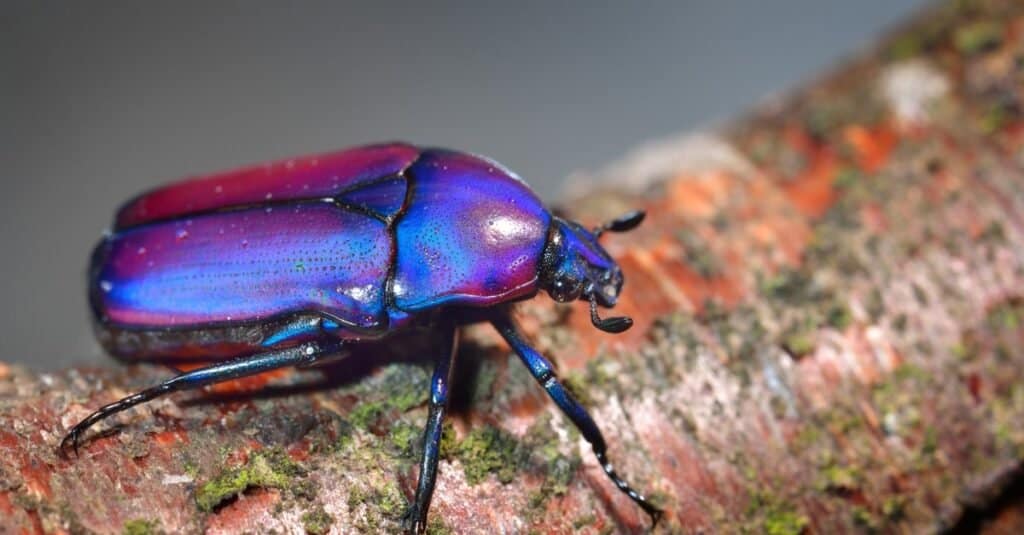
©Alex Stemmers/Shutterstock.com
The scarab beetle or scarab’s scientific name is Scarabaeidae and there are 30,000 species around the world. They have stout bodies with mostly bright, metallic colors, and a size of 1.5-160mm. Their scavenger diet is of carrion, decaying plant matter, and dung. Two common types of scarabs are the Chinese rose beetle and the grapevine beetle.
8. Dung

.
©Mike Laptev/Shutterstock.com
Dung beetles eat feces and their scientific name is Scarabaeoidea. They live in all continents except Antarctica. Their size is 5-50mm and their color mostly ranges from brown to black and is usually shiny, but some have bright, metallic colors.
9. Stag

©iStock.com/KarelGallas
The scientific name of the stag beetle is Lucanidae, while its common name in English refers to its large jaws which make for easy identification. There exist 1,200 species, all with a diet of plant sap. Their size is 0.5-5 inches and their colors are red, brown, green, and black.
10. Soldier

©Suede Chen/Shutterstock.com
Also called leatherwings, soldier beetles have soft wing-cases and straight sides. Their scientific name is Cantharidae and there exist 35,000 species. Their size is 8-13mm and their colors range from yellow to red with brown or black wings, with their English name referring to the look of a British redcoat. They secret a toxic defensive chemical and their diet is plant-eating insects.
11. Firefly
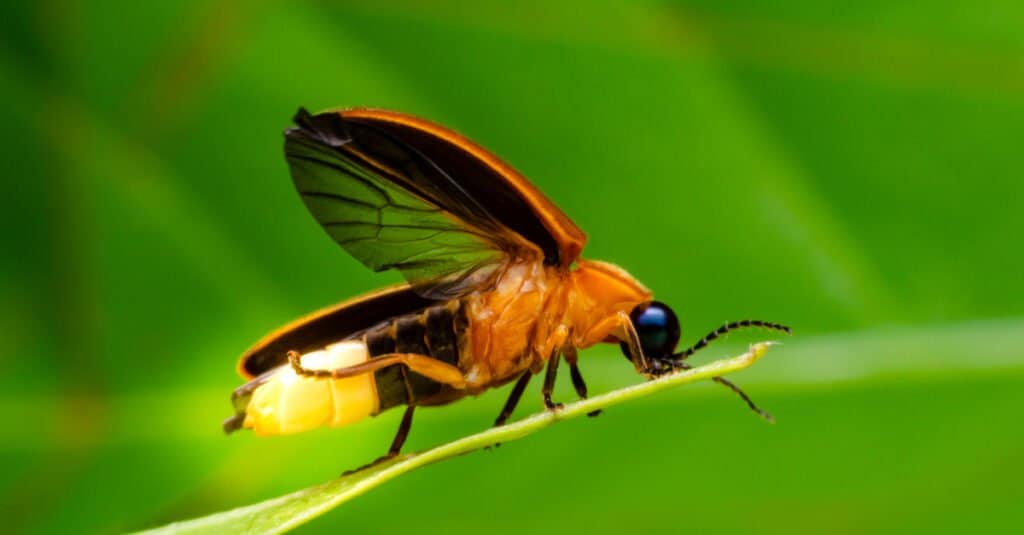
©khlungcenter/Shutterstock.com
Fireflies are named for their bioluminescence at night and are also called glowworms and lightning bugs. Their scientific name is Lampyridae and they live all over the world in various habitats. Varying in physical features, their diet depends on the species and ranges from nothing to flower nectar or pollen to smaller fireflies and soft-bodied ground-dwelling animals.
12. Squash

©Huw Penson/Shutterstock.com
Squash beetles are often confused with ladybugs or cucumber beetles due to their yellow to orange colors and are also called squash lady beetles and squash ladybugs. They have seven black spots on each wing covering and four smaller ones on their thorax. Epilachna borealis is their scientific name and their diet is gourd or squash plants. They live in North America and their size is 7-10mm.
13. Potato Bug
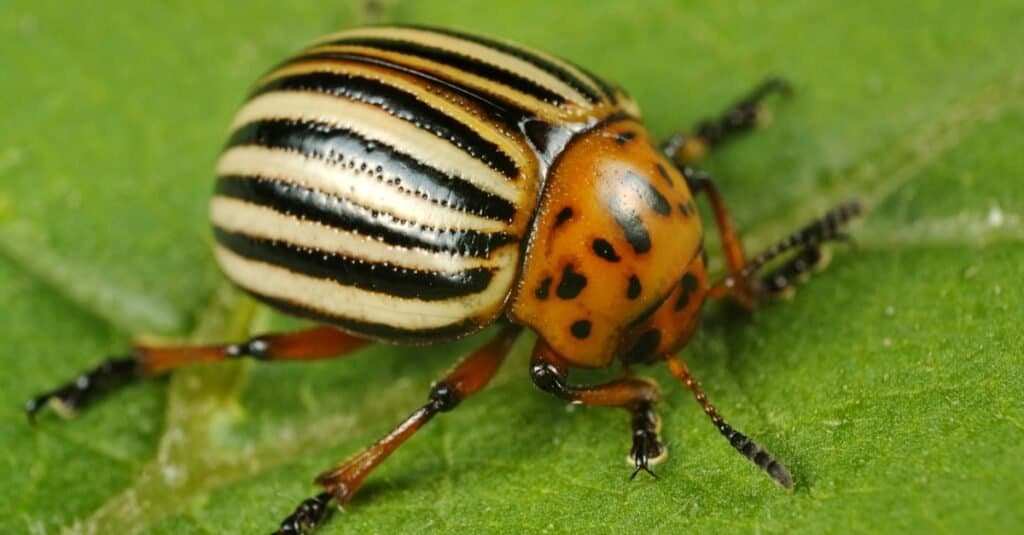
world.
©D. Kucharski K. Kucharska/Shutterstock.com
Also called Colorado potato beetles, Colorado beetles, ten-lined potato beetles, or ten-striped spearmen, potato bugs are actually found in Mexico and most of the United States. Leptinotarsa decemlineata is their scientific name. Their size is 6-11mm and their colors are orange-yellow with 10 black stripes on their wing-cases.
14. Leaf

©Gerry Bishop/Shutterstock.com
Leaf beetles have the scientific name of Chrysomelidae and there exist over 37,000 species. With 2,500 genera, they are one of the most common types of beetles around the world, with each species having a diet of certain plants. Their size is 1-35mm and their color and shape vary, so identification comes from the three spots on their thorax. Well-known species are the tortoise beetle and the dogbane beetle.
15. Coconut Hispine
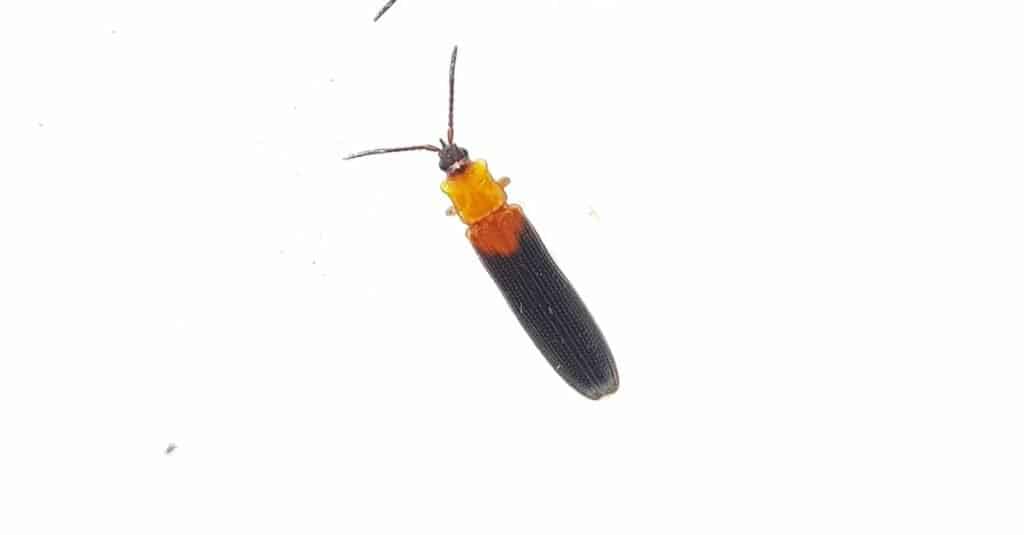
©Lam Van Linh/Shutterstock.com
Brontispa longissima is the scientific name of coconut hispine beetles, which are also called coconut leaf beetles and two-colored coconut leaf beetles. They live in Asia, Southeast Asia, and Oceania, where their diet is coconuts, betel nut, and ornamental and wild palms. Their size is 8-10mm and their colors are mostly reddish-brown to black with lighter heads and antennae.
16. Mountain Pine
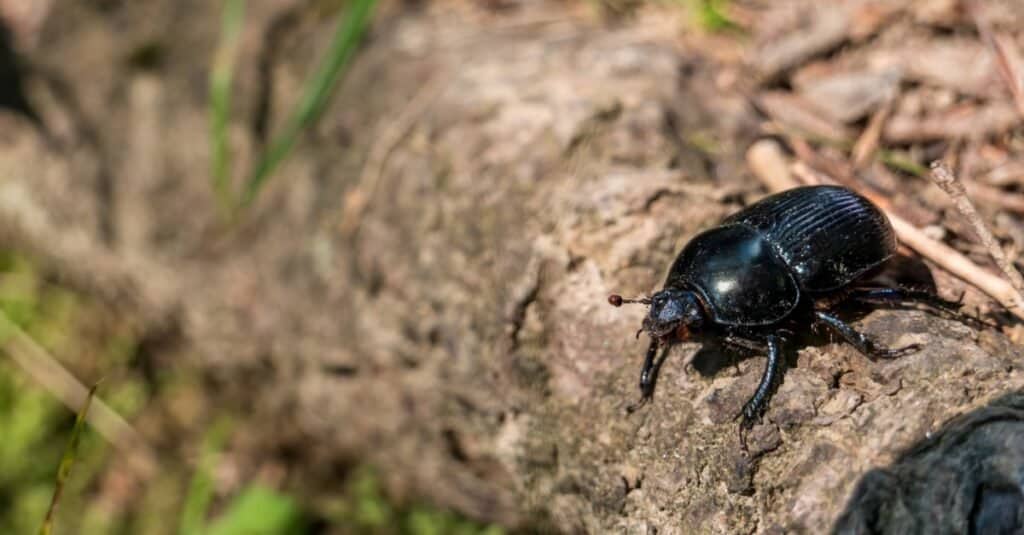
©Cristi Croitoru/Shutterstock.com
Mountain pine beetles are a type of bark beetle and have the scientific name of Dendroctonus ponderosae. They are native to western North America where they live and eat limber, jack, Scots, lodgepole, whitebark, and ponderosa pine tree bark. All have a dark black exoskeleton and are a quarter-inch in size.
17. Japanese
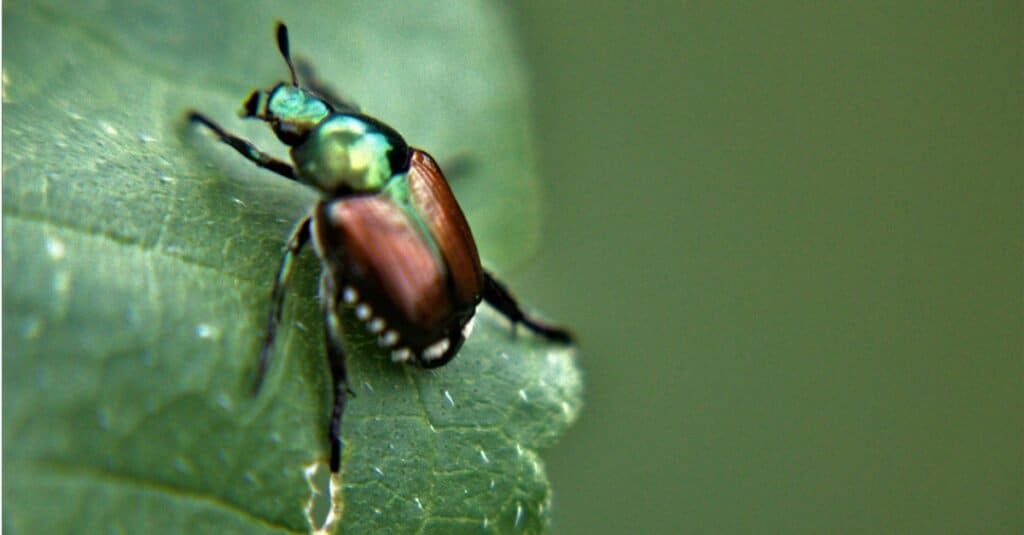
©iStock.com/Justin Tahai
Japanese beetles are a type of scarab beetle that is native to Japan, although they are found all over the world. They have an herbivorous diet, their colors are green or golden and their size is 15mm.
18. Hercules

©feathercollector/Shutterstock.com
Hercules beetles are a type of rhinoceros beetle and are just one of the many different types of beetles in the scarab family, with the scientific name Dynastes hercules. Identification of males comes from their large horns, which females do not have, as well as their size of 1.5-7 inches including their horns or 2-3.3 inches without. They also make a huffing sound when threatened. These rare beetles are native to the Lesser Antilles, South America, and Central America, and their diet is strictly herbivorous.
19. Atlas
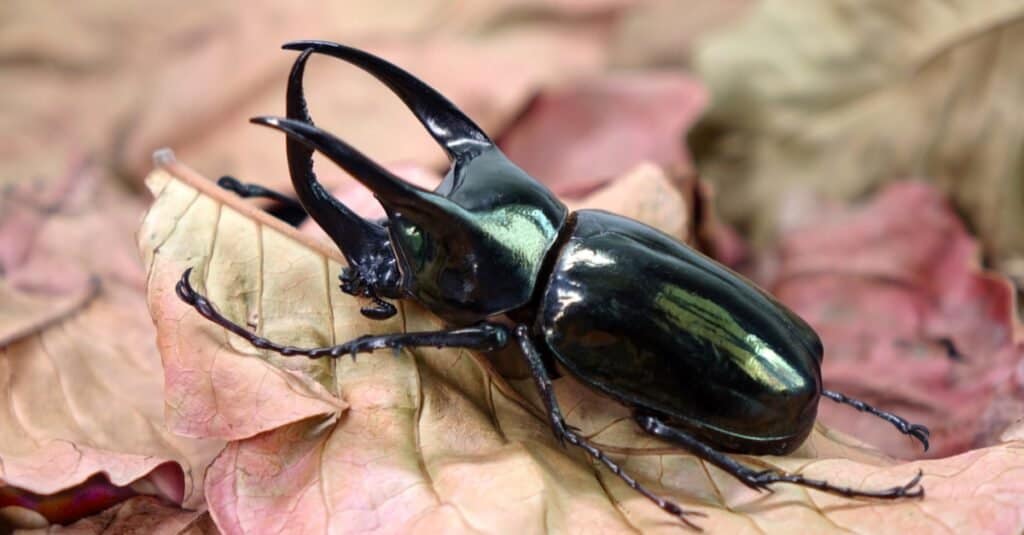
©Mark Brandon/Shutterstock.com
Identification of male Atlas beetles comes from their three horns. Named after the Greek mythological figure of Atlas who held up the world, they can lift up to 4 grams. Their scientific name is Chalcosoma atlas and all members of the genus Chalcosoma are very large in size, while this particular species has a broader head horn. They live in Southeast Asia, their colors are metallic green, grey, or black, and their diet is decaying vegetables and fruit. The size of males is 60-120mm and that of females is 25-60mm.
20. Click
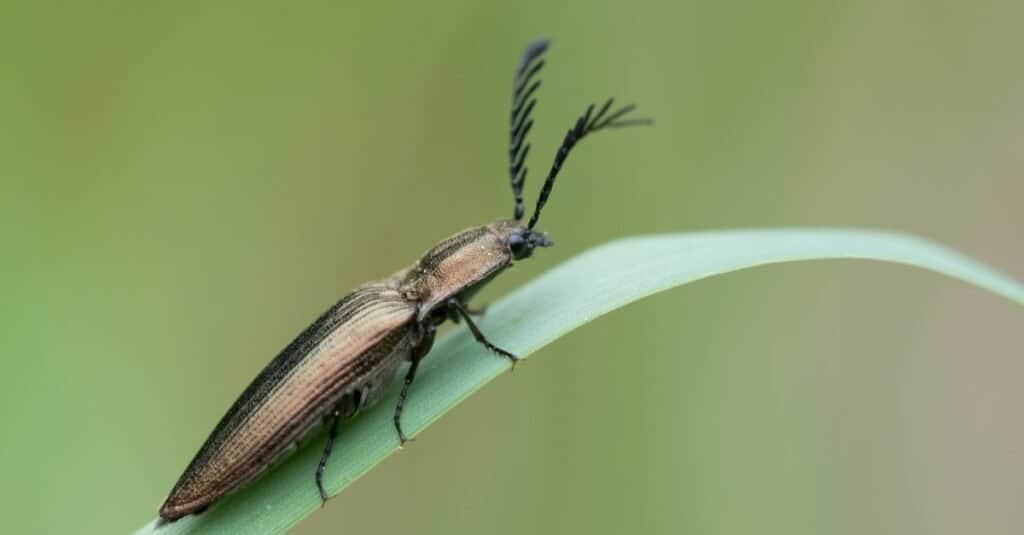
©Karolsejnova/Shutterstock.com
Also called elaters, skipjacks, spring beetles, or snapping beetles, click beetles are named for their unique clicking sound. Their scientific name is Elateridae. The size of most is under 2cm with long, rectangular, brown, or black bodies and no markings, although some are large and colorful. They live in warm climates with high vegetation and their diet is herbivorous.
21. Black Caterpillar Hunter
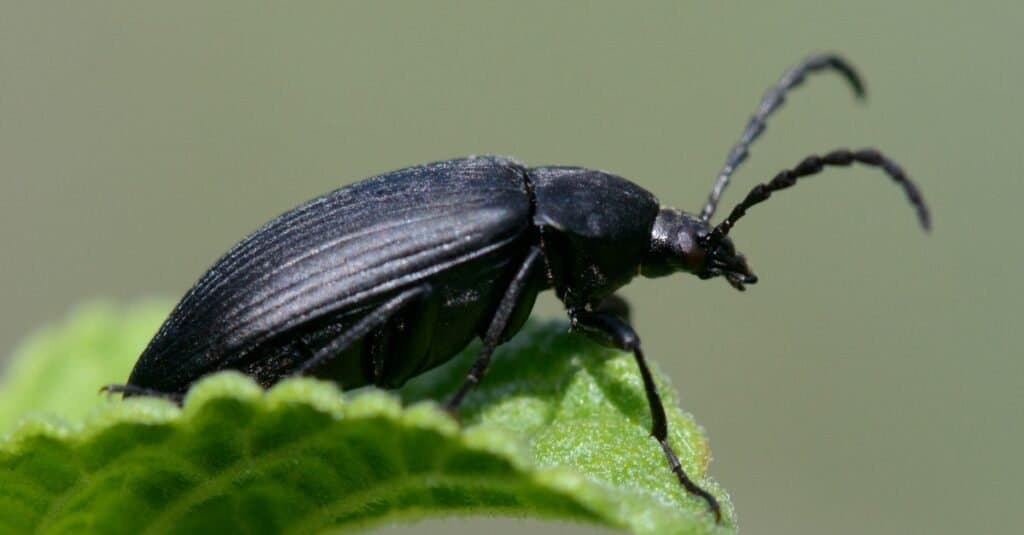
©iStock.com/MichaelRLopez
Also called Say’s caterpillar hunters, black caterpillar hunters have the scientific name of Carabinae. They are 25-28mm long with shiny black bodies and grooved wing-cases with rows of ruby-red pits. They live on woodlands and gardens of the southern United States, where their diet is the larvae and pupae of grubs, flies, caterpillars, and moths.
22. Tiger
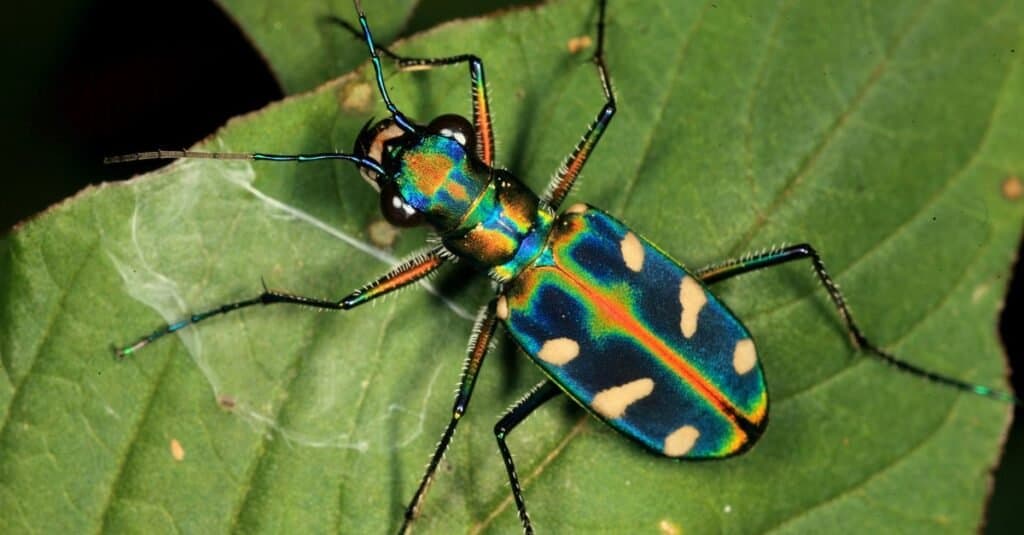
©wagtail/Shutterstock.com
Tiger beetles have the scientific name Cicindelinae. There are 2,600 species, which are known for running up to 5.6 mph and their predatory aggression. Their size is up to an inch long and they have metallic shells in various colors, large, curved jaws, long legs, and bulging eyes. They live in tropical regions, where their diet is other small insects and arthropods.
23. Deathwatch
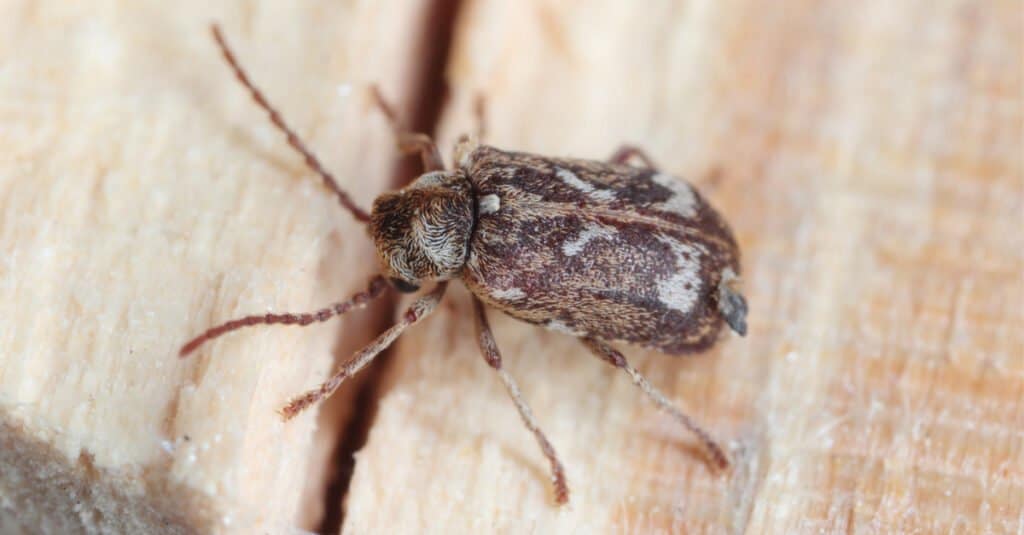
©Tomasz Klejdysz/Shutterstock.com
Feeding on a diet of old oak and other types of wood, deathwatch beetles are known for being pests in wooden buildings. Their colors are brown, black, and white and they are about 7mm in size. Named after the tapping sounds the males make, they were thought to be death omens. They are native to Britain and live in temperate woodlands.
24. Checkered
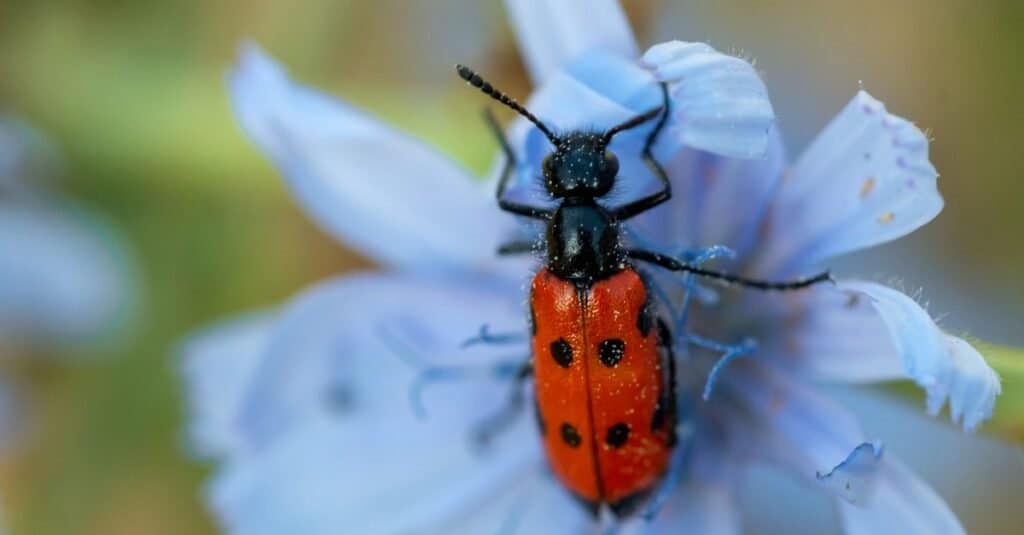
©iStock.com/Irina Chayko
Checkered beetles live around the world and have different diets and habitats. Their scientific name is Cleroidea. Long and oval with bristly hairs, they are 3-24mm and most have bright color patterns.
25. Blister
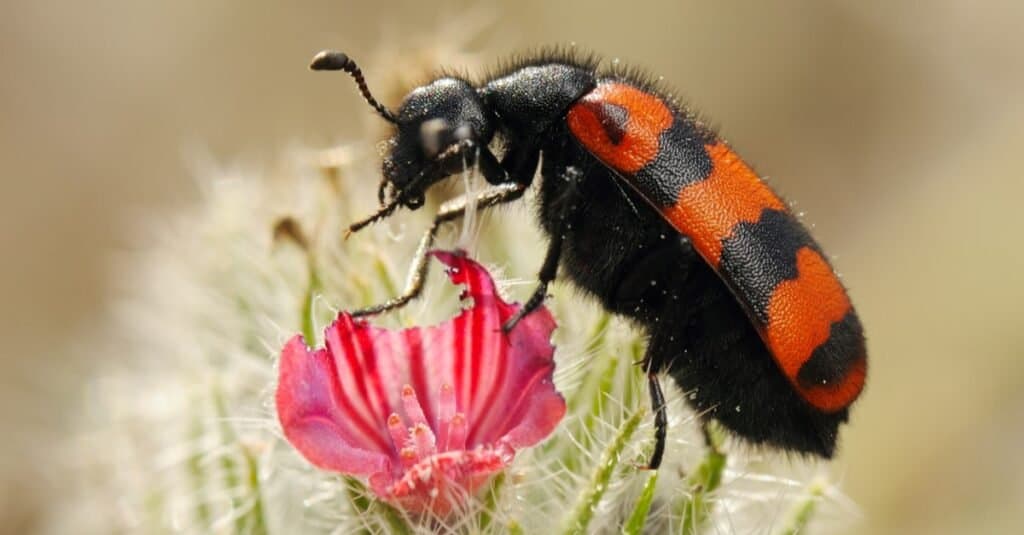
©vblinov/Shutterstock.com
Named after the blistering agent they secrete called cantharidin, blister beetles have the scientific name of Meloidae. 7,500 species exist around the world. They come in brought colors and a size of 1-2.5cm, while their diet is omnivorous.
26. Sawyer

©Mikhail Kochiev/Shutterstock.com
Sawyers or sawyer beetles have the scientific name Monochamus. They are a worldwide genus of longhorn beetles that eat conifer trees, especially pines, and are known for having long antennae and camouflage colors. They’re about an inch long.
27. Whirligig

©Maximillian cabinet/Shutterstock.com
Whirligig beetles are a type of water beetle that is named for swimming in circles when threatened. Their scientific name is Gyrinidae, and there are 700 species with 15 genera around the world. Their diet is insectivorous, eating soft-bodied larvae and adult insects such as flies. They have oval, brownish-black bodies 3-18mm in size, tiny, clubbed antennae, and horizontally divided eyes.
28. Emerald Ash Borer
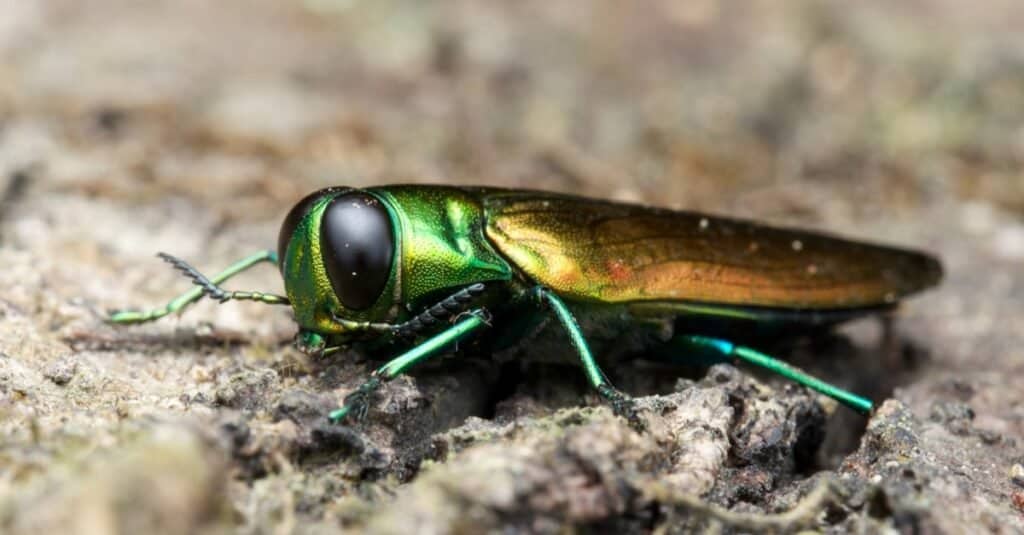
©Herman Wong HM/Shutterstock.com
Native to northeast Asia, emerald ash borers are jewel beetles named after their color and diet of ash trees. Their scientific name is Agrilus planipennis and their size is 8.5mm.
29. Fiery Searcher
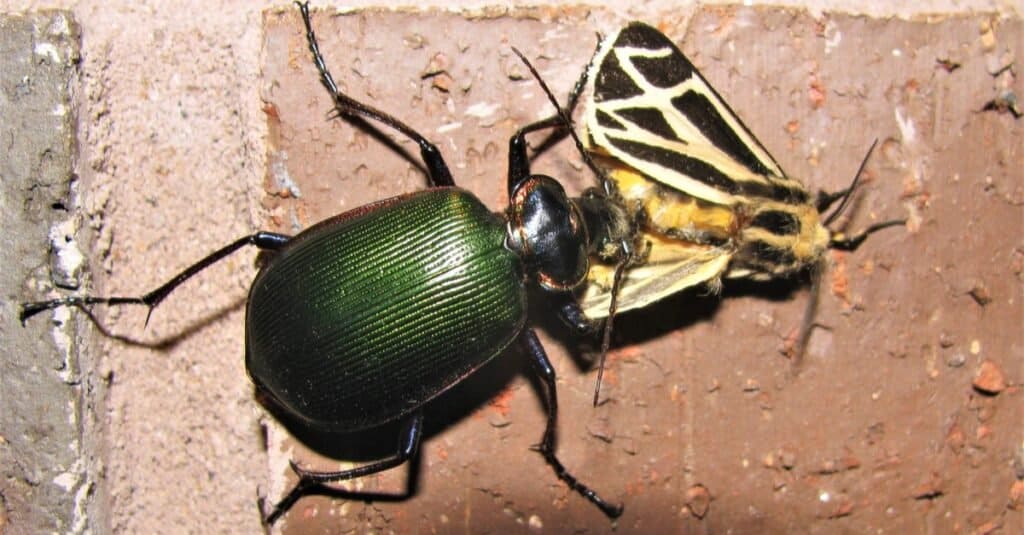
©Kevin Jarrell/Shutterstock.com
Fiery searchers or caterpillar hunters are a ground beetle species with the scientific name of Calosoma scrutator. They measure up to 1.4in (35mm) long. Found in North, Central, and South America, they are most abundant in the eastern United States. They secrete oil that smells like rancid olive oil or rotten milk when threatened.
30. Green June
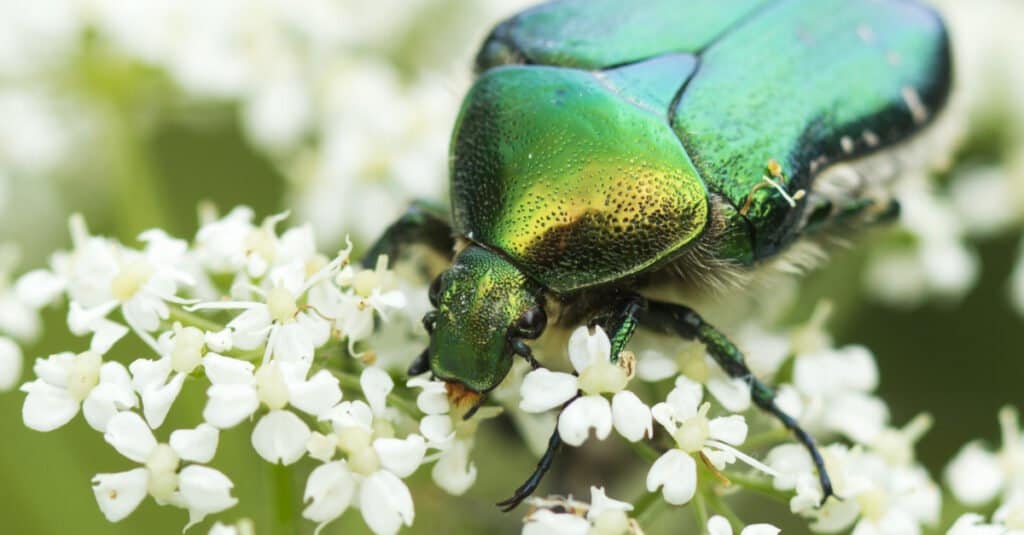
©Galina Savina/Shutterstock.com
Found in the eastern United States and Canada, green June beetles are turf pests that eat a variety of vegetation. They are also called May beetles or June bugs. With green wings, bright, shiny green underside, legs, head, and gold sides, they measure 15-22mm long. Their scientific name is Cotinis nitida.
How Long do Beetles Live?
The lifespan of a beetle is relatively short. Its lifecycle begins with the mating season between spring and autumn, where male and female beetles mate or reproduction occurs asexually. The mother will typically choose the same habitat she was raised in to produce her offspring. She will lay her eggs directly on the source of food, whether it’s wood, plant leaves, feces, or a place with sufficient prey. The eggs can hatch within a few days or up to a few months. The baby larvae go through the larval stage where they feed, grow larger, and shed their exoskeletons.
Developing beetles then go through the pupa stage. Some beetles take only a few weeks to transform, whereas other species take a few years. During this time, the pupa does not eat instead remaining in a dormant state of reduced activity. Once the beetles emerge as adult beetles, their lifespan can vary from 10 days to 6 months, depending on the species.
Summary of the Types of Beetles
| Beetle | Scientific Name | Size | |
|---|---|---|---|
| 1 | Ladybug | Coccinellidae | 0.8-18mm |
| 2 | Carrion | Silphidae | 9-30mm |
| 3 | Flesh-eating | Dermestidae | 10-25mm |
| 4 | Rove | Staphylinidae | 2-7.6mm |
| 5 | Weevil | Curculionoide | 6mm |
| 6 | Ground | Carabus intricatu | 0.15 cm-3.0 cm |
| 7 | Scarab | Scarabaeidae | 1.5-160mm |
| 8 | Dung | Scarabaeoidea | 5-50mm |
| 9 | Stag | Lucanidae | 1.27-12.7cm |
| 10 | Soldier | Cantharidae | 8-13mm |
| 11 | Firefly | Lampyridae | 2.5cm |
| 12 | Squash | Epilachna borealis | 7-10mm |
| 13 | Potato | Leptinotarsa decemlineata | 6-11mm |
| 14 | Leaf | Chrysomelidae | 1-35mm |
| 15 | Coconut Hispine | Brontispa longissima | 8-10mm |
| 16 | Mountain Pine | Dendroctonus ponderosae | 6.35mm |
| 17 | Japanese | Popillia japonica | 15mm |
| 18 | Hercules | Dynastes hercules | 1.5-7in |
| 19 | Atlas | Chalcosoma atlas | 25-120mm |
| 20 | Click | Ctenicera pectinicornis | Up to 2cm |
| 21 | Black Caterpillar Hunter | Calosoma sayi | 25-28mm |
| 22 | Tiger | Cicindelinae | Up to 25.4mm |
| 23 | Deathwatch | Xestobium rufovillosum | 7mm |
| 24 | Checkered | Enoclerus rosmarus | 3-24mm |
| 25 | Blister | Meloidae | 1-2.5cm |
| 26 | Sawyer | Monochamus sutor | 5cm |
| 27 | Whirligig | Gyrinus natator | 3-18mm |
| 28 | Emerald Ash Borer | Agrilus planipennis | 8.5mm |
| 29 | Fiery Searcher | Calosoma scrutator | 1.4in (35mm) |
| 30 | Green June | Cotinis nitida | 15-22mm |
Thank you for reading! Have some feedback for us? Contact the AZ Animals editorial team.






